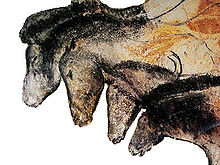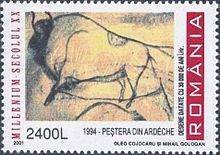- Chauvet Cave
-
The Chauvet-Pont-d'Arc Cave is a cave in the Ardèche department of southern France that contains the earliest known cave paintings, as well as other evidence of Upper Paleolithic life.[1] It is located near the commune of Vallon-Pont-d'Arc on a limestone cliff above the former bed of the Ardèche River. Discovered on December 18th, 1994, it is considered one of the most significant prehistoric art sites.
The cave was first explored by a group of three speleologists: Eliette Brunel-Deschamps, Christian Hillaire, and Jean-Marie Chauvet, for whom it was named. Chauvet (1996) has a detailed account of the discovery. On top of the paintings and other human evidence they also discovered fossilized remains, prints, and markings from a variety of animals, some of which are now extinct. Further study by French archaeologist Jean Clottes has revealed much about the site, though the dating has been the matter of some dispute.
Contents
Features
The cave is situated above the previous course of the Ardèche River before the Pont d'Arc opened up. The gorges of the Ardèche region are home to numerous caves, many of them having some geological or archaeological importance. The Chauvet Cave is uncharacteristically large and the quality, quantity, and condition of the artwork found on its walls have been called spectacular. Based on radiocarbon dating, the cave appears to have been used by humans during two distinct periods: the Aurignacian and the Gravettian.[2] Most of the artwork dates to the earlier, Aurignacian, era (30,000 to 32,000 years ago). The later Gravettian occupation, which occurred 25,000 to 27,000 years ago, left little but a child's footprints, the charred remains of ancient hearths and carbon smoke stains from torches that lit the caves. After the child's visit to the cave, evidence suggests that the cave had been untouched until discovered in 1994.[3] The footprints may be the oldest human footprints that can be dated accurately.
The soft, clay-like floor of the cave retains the paw prints of cave bears along with large, rounded, depressions that are believed to be the "nests" where the bears slept. Fossilized bones are abundant and include the skulls of cave bears and the horned skull of an ibex.[4]
Paintings
Hundreds of animal paintings have been catalogued, depicting at least 13 different species, including some rarely or never found in other ice age paintings. Rather than depicting only the familiar animals of the hunt that predominate in Paleolithic cave art, i.e. horses, cattle, reindeer, etc., the walls of the Chauvet Cave include many predatory animals: Cave lions, panthers, bears, owls, and Cave Hyenas. Also pictured are rhinos.
Typical of most cave art, there are no paintings of complete human figures, although there is one possible partial "Venus" figure that may represent the legs and genitals of a woman. Also a chimerical figure may be present; it appears to have the lower body of a woman with the upper body of a bison. There are a few panels of red ochre hand prints and hand stencils made by spitting pigment over hands pressed against the cave surface. Abstract markings—lines and dots—are found throughout the cave. There are also two unidentifiable images that have a vaguely butterfly shape to them. This combination of subjects has led experts in prehistoric art and cultures to believe that there was likely a ritual, shamanic, or magical aspect to these paintings.
The artists who produced these unique paintings used techniques not often seen in other cave art. Many of the paintings appear to have been made only after the walls were scraped clear of debris and concretions. This left a smoother and noticeably lighter area upon which the artists worked. Similarly, a three dimensional quality is achieved by incising or etching about the outlines of certain figures. This visually emphasizes some of the animals and allows torch light to cast shadows about the edges.
Dating
The cave contains the oldest known cave paintings, based on radiocarbon dating of "black from drawings, from torch marks and from the floors", according to Jean Clottes. Clottes concludes that the "dates fall into two groups, one centred around 27,000-26,000 BP and the other around 32,000-30,000 BP."[1] As of 1999, the dates of 31 samples from the cave had been reported. The earliest, sample Gifa 99776 from "zone 10", dates to 32,900±490 BP.[5]
However, some archaeologists have questioned these dates. Christian Züchner, based on stylistic comparisons with similar paintings at other well dated sites, is of the opinion that the red paintings are from the Gravettian period (c. 28,000–23,000 BP) and the black paintings are from the Early Magdalenian period (early part of c. 18,000–10,000 BP).[6] Pettitt and Bahn also believe the dating is inconsistent with the traditional stylistic sequence and that there is uncertainty about the source of the charcoal used in the drawings and the extent of surface contamination on the exposed rock surfaces.[7][8] New stylistic studies show that some Gravettian engravings are superimposed on black paintings proving the paintings' older origins.[9]
By 2011, over 80 radiocarbon dates had been taken, with samples from torch marks and from the paintings themselves, as well as from animal bones and charcoal found on the cave floor. The radiocarbon dates from these samples suggest that there were two periods of creation in Chauvet: 35,000 years ago and 30,000 years ago.[10]
See also
- Cave of Forgotten Dreams - a documentary film about Chauvet Cave by Werner Herzog
Notes
- ^ a b Clottes (2003b), p. 214.
- ^ See the section on Dating.
- ^ Curtis, Gregory, The Cave Painters: Probing the Mysteries of the World's First Artists. Knopf: New York, NY, USA, 2006, pp. 215-216
- ^ Smithsonian Magazine, December 2010
- ^ Clottes (2003b), p. 33. See also Chauvet (1996), p. 131, for a chronology of dates from various caves. Bahn's foreword and Clottes' epilogue to Chauvet (1996) discuss dating.
- ^ Züchner, Christian (September 1998). "Grotte Chauvet Archaeologically Dated". Communication at the International Rock Art Congress IRAC ´98. http://www.rupestre.net/tracce/12/chauv.html. Retrieved 2007-12-23.
Clottes (2003b), pp. 213-214, has a response by Clottes. - ^ Pettitt, Paul; Paul Bahn (March 2003). "Current problems in dating Palaeolithic cave art: Candamo and Chauvet". Antiquity 77 (295): 134–141. http://www.antiquity.ac.uk/ant/077/Ant0770134.htm.
- ^ Pettitt, P. (2008). "Art and the Middle-to-Upper Paleolithic transition in Europe: Comments on the archaeological arguments for an early Upper Paleolithic antiquity of the Grotte Chauvet art". Journal of Human Evolution, 2008 Aug 2. (abstract)
- ^ Guy, Emmanuel (2004). The Grotte Chauvet : a completely homogeneous art?, paleoesthetique.com, February 2004.
- ^ "A Chauvet Primer". Archaeology 64 (2): 39. March/April 2011.
References
- Chauvet, Jean-Marie; Eliette Brunel Deschamps, Christian Hillaire (1996). Dawn of Art: The Chauvet Cave. Paul G. Bahn (Foreword), Jean Clottes (Epilogue). New York: Harry N. Abrams. ISBN 0810932326.
- English translation by Paul G. Bahn from the French edition La Grotte Chauvet
- Clottes, Jean (2003a). Return To Chauvet Cave, Excavating the Birthplace of Art: The First Full Report. Thames & Hudson. pp. 232. ISBN 0500511195.
- Clottes, Jean (2003b). Chauvet Cave: The Art of Earliest Times. Paul G. Bahn (translator). University of Utah Press. ISBN 0874807581.
- Translation of La Grotte Chauvet, l'art des origins, Éditions du Seuil, 2001
- Clottes, Jean (August 2001). "France's Magical Ice Age Art". National Geographic 200 (2). http://ngm.nationalgeographic.com/ngm/data/2001/08/01/html/ft_20010801.6.html (article includes many photographs)
Further reading
Humphrey, Nicholas (1998): Cave Art, Autism, and the Evolution of the Human Mind. Cambridge Archaeological Journal 8:2 (1998), pp. 165–91
External links
- The Cave of Chauvet-Pont-d'Arc French Ministry of Culture information site; includes an interactive map with photos.
- La grotte préhistorique Chauvet : des Michel-Ange en peaux de bête (French)
- Ancient Grand Masters: Chauvet Cave, France A brief article by Jean Clottes of the French Ministry of Culture, responsible for overseeing the authentication of the contents and art of the cave
- Chauvet Cave (ca. 30,000 b.c.) on the Metropolitan Museum of Art's Timeline of Art History
- Doubt Cast on Age of Oldest Human Art abstract of April 18, 2003 New Scientist article by Jenny Hogan
- Chauvet Cave The cave paintings and rock art of Chauvet, with contributions by Jean Clottes
- The Grotte Chauvet : a completely homogeneous art?
- Chauvet cave An enthusiast site with photographs and articles.
- Cave of Forgotten Dreams a film by Werner Herzog using 3D technology
Coordinates: 44°23′15″N 4°24′51″E / 44.3876116°N 4.4140577°E
Categories:- Limestone caves
- Caves of France
- Wild caves
- Prehistoric sites in France
- Ardèche
- History of Rhône-Alpes
- Caves containing pictograms in France
- Art of the Upper Paleolithic
Wikimedia Foundation. 2010.



